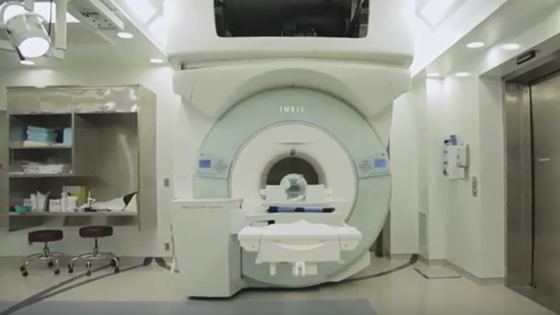
The magnetic resonance guided radiation therapy (MRgRT) suite at the Princess Margaret Cancer Centre. About 50 per cent of cancer patients will experience radiotherapy at some point in their cancer journey. (Photo: Radiation Medicine Program)
UHN staff have been integral in improving the quality and safety of radiation medicine.
They have provided their time and expertise to enhance Ontario's radiation protection legislation and made significant contributions to various projects under the Canadian Partnership for Quality Radiotherapy (CPQR). A recent independent and external review of the CPQR and its work has highlighted the important contributions that have been made to improving radiation treatment quality and safety in Canada.
"We are very proud to have so many of our staff – in radiation oncology, medical physics and radiation therapy – providing system leadership and contributing to this important work," says Dr. Mary Gospodarowicz, Medical Director at the Princess Margaret Cancer Centre.
The CPQR
About half of cancer patients will experience radiotherapy at some point in their cancer journey, either as curative treatment or to ease symptoms. With so many cancer patients going through radiation, quality and safety are critical in providing the best patient care.
Over the last five years, the CPQR has focused its work in four main areas supported by a grant from the Canadian Partnership Against Cancer (CPAC):
- The development of national accreditation standards for radiation treatment programs in collaboration with Accreditation Canada.
- The creation of a national system for incident reporting in radiation treatment (NSIR-RT) with the Canadian Institute for Health Information (CIHI).
- The development and validation of Technical Quality Control (TQC) guidelines to ensure the best performance of radiation treatment equipment.
- Engaging patients and their families more fully to promote high quality and safe radiation treatment.
"The experience of CPQR is the first successful example in the Canadian health care system where professionals from different disciplines work together as a team to improve the quality and safety of their practice," said research group Ference and Company in their recent review of the CPQR.
"This approach can be applied to other areas of the Canadian health care system to improve quality and safety."
The work done by the CPQR is the result of a dedicated group of radiation professionals who volunteer their time outside of their day-to-day work.
Many UHN staff have contributed to this work at various stages, notably Dr. Michael Milosevic, Chair of the CPQR steering committee and Radiation Oncologist at the Princess Margaret; Jean-Pierre Bissonnette, who spearheaded work on the TQC guidelines and is the Radiation Physics Lead for the Lung group at the Princess Margaret; and Caitlin Gillan, a radiation therapist at the Princess Margaret.
"This work has involved considerable contributions from UHN staff," says Dr. Milosevic. "There is an interdisciplinary nature to the UHN engagement in this project – oncology, physics and radiation therapy – which is fundamental to the safe delivery of high quality radiation treatment."
"That interdisciplinary nature is a core element of our program at UHN, and key to the success of CPQR."
For more information, visit the
Canadian Partnership for Quality Radiotherapy (CPQR) website.
Radiation Protection Legislation
In addition to UHN staff involvement with the CPQR, they have also been working to support Health Quality Ontario in its work to modernize the province's radiation protection legislation.
The
Expert Panel to Enhance the Safety and Quality of Energy-Applying Medical Devices (EAMDs) was established by Health Quality Ontario (HQO) to provide recommendations to the Ministry of Health and Long-Term Care for modernizing Ontario's radiation protection legislation.
Led by Co-Chairs Dr. David Jaffray, UHN's Executive Vice-president Technology and Innovation, and Dr. Timothy Dowdell, Radiologist-In-Chief, Department of Medical Imaging, St. Michael's Hospital, the panel provided more than 30 recommendations for the modernization of the legislation around quality and safety.
UHN panel members include:
- Paul Cornacchione, Clinical Director, Joint Department of Medical Imaging; Medical Radiation Technologist, UHN
- Sophie Foxcroft, Director, Operations, Radiation Medicine Program, Princess Margaret Cancer Centre
- Michael Milosevic, Radiation Oncologist and Clinician Scientist, UHN, and Chair, CPQR
- Murray Rice, Clinical Engineer, UHN
For more information, read the full
Health Quality Ontario report.
